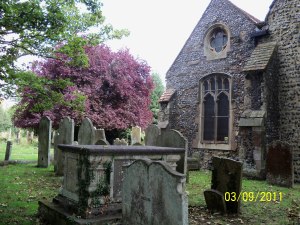Ten o’clock on Saturday morning found me in the churchyard of St Laurence in Ramsgate, about to embark upon the guided tour I have somehow managed to miss on several previous occasions. Unintentionally miss, let me add hastily but, this time, I made it. And very glad I am that I did. The sun was shining, the birds practising their scales in the trees and though St Laurence is situated on a somewhat busy intersection, the noise of the traffic scarcely registered, especially as one ventured further into the tranquil hush of the churchyard. Barbara, our guide, a lady who exuded both bonhomie and efficiency, duly gathered her small, surprisingly age-diverse flock, and shepherded us off on what turned out to be a most interesting tour of the past.
Obedient as school kids, we crocodiled down pathways bordered by topsy-turvy ivy and lichen covered headstones, traipsed across over-grown graves, carefully avoiding the stinging nettles lurking with intent, and ducked beneath bowers of holly, bejewelled with the reddest of berries. Every so often we stopped to allow Barbara to introduce us to the incumbent of a particular grave, along with a potted account of their lives.
And there, in the heart of this relatively unremarked churchyard, we found ourselves in the presence of luminaries such as the eminent lawyer, barrister and politician, William Garrow, recently the subject of a TV series, Garrow’s Law, and the gentleman responsible for that cornerstone of British law, ‘innocent until proven guilty’. In his will, I have since learned, he requested that he be buried in his birthplace, Hadley, alongside his uncle, a request which was for reasons unknown not granted.
In a shady nook, overhung by arthritically-twisted branches, stands a cross marking the final resting place of John Collis Brown, the doctor who invented chlorodyne, originally a treatment for cholera. Although savvy in medical matters, he was no Sir Alan and failed to patent his prescription leaving him to miss out on the profits of what became a ‘miracle’ cure for everything, from colds and diarrhoea to whooping cough, neuralgia and rheumatism. Amongst its principal ingredients were laudanum, tincture of cannabis and chloroform, meaning, as Barbara wryly pointed out, that even if it didn’t cure you, at least you died happy!
The jewel, or perhaps what ought to be the jewel in the crown of St Laurence were it not in so parlous a state with broken ducal coronets and smashed angel heads, is the D’Este mausoleum, in which lie the remains of two of the grandchildren of King George III. Lady Augusta Murray of Dunmore , their mother, who married Prince Augustus Frederick in 1793, shares the same resting place. Unfortunately, under the Royal Marriage Act of 1772, the marriage was ruled invalid and the couple parted in 1801. She was given (or perhaps paid off with) the title, D’Ameland in 1806, and given a Crown allowance to keep her and her children in a certain style.
Leaving Lady Augusta and her offspring in the guardianship of the four-trees standing sentry, one at each corner of the once-grand mausoleum, we pressed onward to where John Woolward, an admiral who served under Nelson, came to anchor for the final time. In 1798 he fought in the Battle of the Nile at Aboukir Bay, helping Nelson to scatter the French fleet and put them to rout. John later became the harbourmaster at Ramsgate, a position he maintained for twenty-six years.
But it wasn’t just the dignitaries I found interesting – I was particularly taken with the grave of a young lady who ‘as she was walking upon the cliff on October 1801, unfortunately she fell over and was killed upon the spot’. There is no name upon the gravestone, but she was later identified as Louisa Grevis. Who said exercise is good for you!
Although many of the stones carry, in keeping with the Victorians, rather grim reminders of the fleetingness of life and a basic caution to refrain from smugness because we’re all on the same bus, just on different time tables, St Laurence churchyard really is something of a haven. One section of the grounds has been left to revert to nature and nature has not been backward at coming forward. Lothario Bees flirted shamelessly with the wild flowers, visiting first one, then another, while Ladybirds lolled about on long sunny stems and leaves, totally unconcerned that their house might be on fire and their children alone. The birds, as I mentioned earlier, were tuning up en mass for the feathered version of The Proms and, I understand, that burning bright in the churchyard of the night is, no, not a tiger, but a fox, waiting, perhaps, for an exhausted songster to fall off its perch.
I could go on. I could tell you how privileged I felt following in the footsteps of William IV, Queen Victoria, even William Pitt, all who have trod the leafy pathways of St Laurence at one point or another, but I won’t. Instead, I suggest you come on one of the tours yourself, which are held regularly and which are free – though it goes without saying that a donation towards the upkeep is always acceptable.
And, I could go on about the church itself, which dates from 1062 – yep, before the Norman conquest, but I also suggest you come along and see its many architectural and historic gems at first hand.
On which note, I will leave the last word to one of our Victorian forebears, whose stone is inscribed with a verbal two fingers up!
‘Farewell vain world, I‘ve known enough of thee
And now care not what thou sayest of me’.
Further information can be found on: http://www.whatsoninkentlocal.com/all/details/21135/

